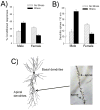Critical brain circuits at the intersection between stress and learning
- PMID: 20153364
- PMCID: PMC2900534
- DOI: 10.1016/j.neubiorev.2010.02.002
Critical brain circuits at the intersection between stress and learning
Abstract
The effects of stressful life experience on learning are pervasive and vary greatly both within and between individuals. It is therefore unlikely that any one mechanism will underlie these complicated processes. Nonetheless, without identifying the necessary and sufficient circuitry, no complete mechanism or set of mechanisms can be identified. In this review, we provide two anatomical frameworks through which stressful life experience can influence processes related to learning and memory. In the first, stressful experience releases stress hormones, primarily from the adrenals, which directly impact brain areas engaged in learning. In the second, stressful experience indirectly alters the circuits used in learning via intermediary brain regions. Importantly, these intermediary brain regions are not integral to the stress response or learning itself, but rather link the consequences of a stressful experience with circuits used to learn associations. As reviewed, the existing literature provides support for both frameworks, with somewhat more support for the first but sufficient evidence for the latter which involves intermediary structures. Once we determine the circumstances that engage each framework and identify which one is most predominant, we can begin to focus our efforts on describing the neuronal and hormonal mechanisms that operate within these circuits to influence cognitive processes after stressful life experience.
Figures







Similar articles
-
Early life experience shapes the functional organization of stress-responsive visceral circuits.Physiol Behav. 2011 Sep 26;104(4):632-40. doi: 10.1016/j.physbeh.2011.04.008. Epub 2011 Apr 13. Physiol Behav. 2011. PMID: 21497616 Free PMC article. Review.
-
The stressed female brain: neuronal activity in the prelimbic but not infralimbic region of the medial prefrontal cortex suppresses learning after acute stress.Front Neural Circuits. 2013 Dec 20;7:198. doi: 10.3389/fncir.2013.00198. eCollection 2013. Front Neural Circuits. 2013. PMID: 24391548 Free PMC article.
-
The bed nucleus of the stria terminalis modulates learning after stress in masculinized but not cycling females.J Neurosci. 2008 Jun 18;28(25):6383-7. doi: 10.1523/JNEUROSCI.0831-08.2008. J Neurosci. 2008. PMID: 18562608 Free PMC article.
-
Investigating learning-related neural circuitry with chronic in vivo optical imaging.Brain Struct Funct. 2020 Mar;225(2):467-480. doi: 10.1007/s00429-019-02001-9. Epub 2020 Jan 31. Brain Struct Funct. 2020. PMID: 32006147 Free PMC article. Review.
-
Evidence for sex-specific shifting of neural processes underlying learning and memory following stress.Physiol Behav. 2010 Feb 9;99(2):204-11. doi: 10.1016/j.physbeh.2009.04.011. Epub 2009 Apr 17. Physiol Behav. 2010. PMID: 19376144 Review.
Cited by
-
Acute stress yields a sex-dependent facilitation of signaled active avoidance in rats.bioRxiv [Preprint]. 2024 Apr 29:2024.04.27.591470. doi: 10.1101/2024.04.27.591470. bioRxiv. 2024. Update in: Neurobiol Stress. 2024 Jun 13;31:100656. doi: 10.1016/j.ynstr.2024.100656. PMID: 38746268 Free PMC article. Updated. Preprint.
-
Adolescent female C57BL/6 mice with vulnerability to activity-based anorexia exhibit weak inhibitory input onto hippocampal CA1 pyramidal cells.Neuroscience. 2013 Jun 25;241:250-67. doi: 10.1016/j.neuroscience.2013.03.020. Epub 2013 Mar 21. Neuroscience. 2013. PMID: 23523748 Free PMC article.
-
Sex differences in fear extinction.Neurosci Biobehav Rev. 2019 Aug;103:81-108. doi: 10.1016/j.neubiorev.2019.05.020. Epub 2019 May 23. Neurosci Biobehav Rev. 2019. PMID: 31129235 Free PMC article. Review.
-
Mindfulness and Other Simple Neuroscience-Based Proposals to Promote the Learning Performance and Mental Health of Students during the COVID-19 Pandemic.Brain Sci. 2021 Apr 27;11(5):552. doi: 10.3390/brainsci11050552. Brain Sci. 2021. PMID: 33925627 Free PMC article. Review.
-
Glucocorticoid receptor regulation of action selection and prefrontal cortical dendritic spines.Commun Integr Biol. 2013 Nov 1;6(6):e26068. doi: 10.4161/cib.26068. Epub 2013 Aug 19. Commun Integr Biol. 2013. PMID: 24563705 Free PMC article.
References
-
- Aerni A, Traber R, Hock C, Roozendaal B, Schelling G, Papassotiropoulos A, Nitsch RM, Schnyder U, de Quervain DJ. Low-dose cortisol for symptoms of posttraumatic stress disorder. Am J Psychiatry. 2004;161:1488–1490. - PubMed
-
- Aggleton JP, Friedman DP, Mishkin M. A comparison between the connections of the amygdala and hippocampus with the basal forebrain in the macaque. Experimental Brain Research. 1987;67(3):556–68. - PubMed
-
- Anagnostaras SG, Gale GD, Fanselow MS. Hippocampus and contextual fear conditioning: recent controversies and advances.[see comment]. [Review] [81 refs] Hippocampus. 2001;11(1):8–17. - PubMed
-
- Arnsten AF. Catecholamine regulation of the prefrontal cortex. J Psychopharmacol. 1997;11:151–162. - PubMed
-
- Austin MP, Mitchell P, Goodwin GM. Cognitive deficits in depression: Possible implications for functional neuropathology. [References] British Journal of Psychiatry. 2001;178:206. - PubMed
Publication types
MeSH terms
Grants and funding
LinkOut - more resources
Full Text Sources
Medical
Research Materials

